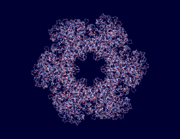Glutamine synthetase
From Proteopedia
(Difference between revisions)
| Line 19: | Line 19: | ||
Glutamine synthetase has been described as having three destinctive types:<ref name="Brown">PMID:7916055 </ref> | Glutamine synthetase has been described as having three destinctive types:<ref name="Brown">PMID:7916055 </ref> | ||
| - | *'''Class I''' (GSI): Genes for this class have only been found in bacteria (eubacteria) and archaea (arhaebacteria. The paper by Kumada ''et. al'' goes into detail on these two.<ref name="Kumada">PMID:8096645 </ref> | + | *'''Class I''' (GSI): Genes for this class have only been found in bacteria (eubacteria) and archaea (arhaebacteria. The paper by Kumada ''et. al'' goes into detail on these two.<ref name="Kumada">PMID:8096645 </ref>. [[Lengsin]] is a member of an ancient branch of this family. |
*'''Class II''' (GSII): Genes for this class have only been found in eukaryotes and a few soil-dwelling bacteria.The paper by Kumada gets into further detail about these bacteria. <ref name="Kumada"/> | *'''Class II''' (GSII): Genes for this class have only been found in eukaryotes and a few soil-dwelling bacteria.The paper by Kumada gets into further detail about these bacteria. <ref name="Kumada"/> | ||
*'''Class III''' (GSIII): Genes from this class have only been found in a few bacterial species.It is a hexamer of identical chains. It is much larger (about 700 amino acids) than the GSI (450 to 470 amino acids) or GSII (350 to 420 amino acids) enzymes. <ref name="Brown"/> Brown ''et. al.''(1994) explain in their paper the idea that lateral gene transfer from archeal GSI may have happened and explain the gene mutation.<ref name="Brown"/> | *'''Class III''' (GSIII): Genes from this class have only been found in a few bacterial species.It is a hexamer of identical chains. It is much larger (about 700 amino acids) than the GSI (450 to 470 amino acids) or GSII (350 to 420 amino acids) enzymes. <ref name="Brown"/> Brown ''et. al.''(1994) explain in their paper the idea that lateral gene transfer from archeal GSI may have happened and explain the gene mutation.<ref name="Brown"/> | ||
Current revision
| |||||||||||
References
- ↑ 1.0 1.1 1.2 Kumada Y, Benson DR, Hillemann D, Hosted TJ, Rochefort DA, Thompson CJ, Wohlleben W, Tateno Y. Evolution of the glutamine synthetase gene, one of the oldest existing and functioning genes. Proc Natl Acad Sci U S A. 1993 Apr 1;90(7):3009-13. PMID:8096645
- ↑ He,Youji, Hakvoort,Theodorus, B.M., Kohler,S.Eleonor, Vermeulen,Jacqueline L.M.,Rudi de Waart, D., Theije,Chiel de, Gabrie A.M. ten Have, Van Eijk,Hans M.H., Kunne,Cindy, Labruyere,Wilelmina T., Houten,Sander M., Sokolovic,Mika, Tuijter,Jan M., Deutz,Nicolaas E.P., and Lamers, Wouter H. Glutamine Synthetase in muscle is required for glutamine production druing fasting and extrahepatic ammonia detoxification. The American Society for Biochemistry and Molecular Biology, January 11, 2010
- ↑ 3.0 3.1 3.2 3.3 3.4 Yamashita MM, Almassy RJ, Janson CA, Cascio D, Eisenberg D. Refined atomic model of glutamine synthetase at 3.5 A resolution. J Biol Chem. 1989 Oct 25;264(30):17681-90. PMID:2572586
- ↑ 4.0 4.1 4.2 Brown JR, Masuchi Y, Robb FT, Doolittle WF. Evolutionary relationships of bacterial and archaeal glutamine synthetase genes. J Mol Evol. 1994 Jun;38(6):566-76. PMID:7916055
| Please do NOT make changes to this Sandbox until after April 23, 2010. Sandboxes 151-200 are reserved until then for use by the Chemistry 307 class at UNBC taught by Prof. Andrea Gorrell. |
Proteopedia Page Contributors and Editors (what is this?)
Michal Harel, Rhiannon Khela, David Canner, Andrea Gorrell, Alexander Berchansky, Jaime Prilusky

